
Another
Nobelist for Berkeley Lab
The Wit and Wisdom
of Steven Chu
Another Nobelist for Berkeley Lab
BY RON KOLB
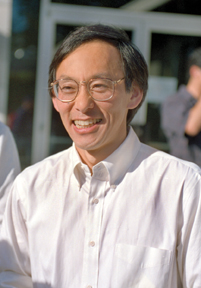 |
|
| Steven Chu | |
This is what we know about Berkeley Lab’s next director, Steven Chu:
- He is overloaded with recognitions for his research, most glittering of them being the 1997 Nobel Prize in Physics.
- After 17 years as a scientist at Stanford, he will have to switch sides at the Big Game because, as University of California President Bob Dynes said, Chu is “a Bear who’s come home to the lair.”
- The fraternity of alumni from the Bell Labs glory days is alive and well at Berkeley (Shank, Chemla, Chu, and even Dynes himself, among others).
- At 56 years old, Chu is embarking on a self-described “phase transition” that he says is both an exciting “privilege” and “a totally terrifying thing.”
- As a scientist, he has encountered almost every discipline in Berkeley Lab’s arsenal — atomic physics, quantum electronics, polymer physics, biology, spectroscopy, even astrophysics.
- And he is the first Asian-American to direct a DOE laboratory, to which he comments, “You’ve got to be kidding.”
Of course, there’s more. Based on an afternoon visit to the Laboratory on June 17, during which the UC Regents named him the Lab’s sixth director via conference call, Chu demonstrated poise, a self-deprecating sense of humor (see sidebar below), a quiet charm, and a humility that reflects his awe of the institution and his acknowledgement of an understandably steep learning curve ahead of him.
But if there’s any question about his capability to manage a $521-million, 4,000-employee, internationally renowned research facility, President Dynes has the answer:
“I defy you to name a more outstanding candidate. Steve brings to this position outstanding leadership qualities and a record of superior achievement in science. His combination of skills is precisely what we need to keep the Lawrence Berkeley National Laboratory at the forefront of scientific excellence and to guide the Lab wisely through the upcoming potential contract competition.”
Dynes was referring to the impending contract bidding process for Berkeley Lab management, which UC has handled for more than 50 years. The congressionally-mandated competition will begin this summer, and though it’s unknown whether or not UC will have an opponent, the University is gearing up for full-scale battle. And Chu is expected to be the field general, which “puts us in a very strong position,” according to Dynes.
A Difficult Decision
Chu confessed to some ambivalence about leaving the research world for administration. He said he spent an “incredibly happy” 17 years at Stanford, during which his work on methods to cool and trap atoms with laser light earned him and two colleagues the Nobel Prize (see “To Catch an Atom,” page 5). That work was actually started during his nine years at Bell Labs, where a manager named Charles Shank gave him the opportunity to pursue the science.
In 1983, Berkeley Lab’s retiring director and Chu’s boss at Bell “asked if I would become a department head in his division. He said, ‘Well, Steve, why don’t you consider coming down and starting a new department, which would be a basic science department here?’”
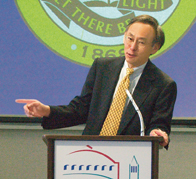 |
|
| Steve Chu at the June 17 press conference announcing his appointment. |
When Chu had some preliminary “eureka” results in that lab, he took them to Shank. “I got very excited,” he recalled, “and said ‘Look, Chuck, I know you’re not keen on this, after years of research, but this is so simple it has a shot at working.’ He thought about that and he said, ‘Well, okay, you’ve earned the right to do something crazy, but don’t try to recruit someone else.’ So I said, “Okay, okay, just my post-doc and my technician.”
And the rest, as they say, is history. Now the employee is about to succeed the boss, and Shank couldn’t be happier.
“Early in Steve’s career it was clear that in addition to being a brilliant scientist he was also a gifted leader,” he said. “When he left a management/scientist job at Bell Laboratories to focus on his science, I was sorry to see him go. Clearly he knew what he was doing since he went off and won the Nobel Prize in physics. I am thrilled to see a person of his stature take over the reins of Berkeley Lab.”
New era begins August 1
He will take over officially on August 1. Directors past and present will be working together during the transition, and Chu said he would be learning about the Lab in greater detail by “talking to as many people as I can in the next few months.”
But he won’t be talking about his “vision.” He was asked by a reporter about that after Dynes had said, “When I first heard [Chu’s] view and vision for the Lab, I was breathtaken.” “They shouldn’t have said that,” Chu laughed. And later, when another reporter asked him where he planned to take the nanoscience program at Berkeley Lab, he was even more blunt.
“This is not where I’m planning on heading,” he said. “Let’s get this straight, that this is a Laboratory of wonderful scientists. They are heading in [the right] direction. What I see here are some wonderful people and groups in divisions that are really excellent, that can come together in ways that they’re beginning to now. And my hopes are that I could somehow make that even better.”
He cited the example of Bell Labs again, where an interdisciplinary approach to problem-solving was the norm. To the division directors, he said, “As a vision goes, it will be yours, too. We’ll be a team. My dream would be to get all of you to know what each other is doing, first on a social level,” so that interactions and partnerships can be sparked. Sounds a lot like the Ernest Lawrence vision of science at Berkeley Lab, doesn’t it?
“I see my job as a facilitator,” he said. “With the senior managers, I see it as creating a structure to allow younger scientists to flower, to go in ways that one doesn’t really anticipate.”
Open door, personal ownership
His management style, he said, will largely draw from his experiences with research teams. “Essentially, my door is open,” he said. “I am willing to hear what needs to be said. One has to give out a lot of responsibility within the structure. Personal ownership is key all the way down the line. People have to be emotionally committed to making things happen.”
Born into a family of academics — his father was a chemical engineer, his mother an economist — Steven Chu and his two brothers grew up in a Brooklyn suburb. Following his graduation from the University of Rochester in 1970, he found his way to graduate school at Berkeley, recruited by campus and lab physicist Eugene Commins. As a grad student and post-doctoral fellow, he had occasion to do some work at the 88-inch Cyclotron and the Heavy Ion Linear Accelerator (HILAC). He recalled earning $350 a month.
“I knew the lab,” Chu said, “and I used to root around in the surplus equipment bins, finding old dead capacitors and such that I could use. The Livermore (Lab) junkyards were the best ever.”
He was offered a job as assistant professor at Berkeley in 1978, but instead he went for the promise of experimentation at Bell Labs. “I never returned to Berkeley,” he wrote in his Nobel autobiography in 1997. “To this day I feel guilty about it, but I think that the faculty understood my decision and have forgiven me.”
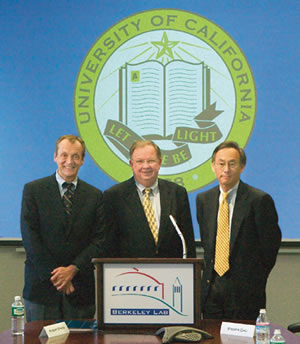 |
|
| Steve Chu (right) poses after the press conference with UC President Robert Dynes (left) and Berkeley Lab Director Charles Shank. | |
Indeed they have, judging from their comments on his Berkeley Lab
appointment. Thanks to mentor Commins’ influence, Chu left the
excitement of Bell Labs because “the urge to spawn scientific
progeny was growing stronger.” Thus began a nearly two-decade
love affair with teaching and research at Stanford, where he twice
served three-year terms as physics department chair and now holds
the Theodore and Francis Geballe professorship in physics and applied
physics. Over the years, more than 20 of his students and postdoctoral
fellows have become professors at the world’s top research universities.
The “Secret Weapon”
During his visit to Berkeley last week, his second wife, Jean, was always by his side. Chu referred to her as “my secret weapon” and indicated that they made the decision to accept the Berkeley Lab offer together. Mrs. Chu is a distinguished academician in her own right — an Oxford-bred physicist who was on the faculty at San Jose State and also served Stanford as director of admissions and executive assistant to former President Gerhard Casper. Between them, they have four grown children — none of them scientists.
The Chus’ Stanford house is on the market (“When they sell their house, you can tell they’re serious,” Dynes said). The search for a new home begins as soon as they return from a scheduled trip to Beijing. The Bear is, indeed, returning to the lair.
“It actually feels like a homecoming,” the Director-elect said. “I’ve had very close relationships with the Berkeley faculty and with people here on the Hill. I am going to be inheriting a laboratory that’s in spectacular shape, that’s extremely well regarded, and that has an incredibly bright future.
And he added, “I have the opportunity to lead what I consider a great national asset that has jewels within it. The Lab is regarded by the Department of Energy as a real treasure, and Charles Shank as one of their best, if not the best, leaders that they’ve ever had. It’s a very exciting time, and I think the horizons over the next decade or so will be very bright.”
The Wit and Wisdom of Steven Chu
Selected quotes from Berkeley Lab’s sixth director:
“Well, if corrected, I’d say it’s 20/20.”
When asked by a reporter one final time his least favorite question: “What is your vision?”
“Already I’m losing people …”
After one of the reporters on the phone press conference hung up, and the operator announced: “Now departing the call …”
“I’m getting long in the tooth (he’s 56), and I’ve done science for 30 odd years. I want 15 more, a fair portion of that in this position. I like the idea of doing something new and different while I can still get air between me and the gym floor.”
Responding to a division director’s question of why he was leaving research to be a manager
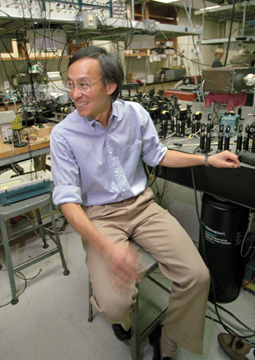 |
|
| Chu in his lab at Stanford University. |
“I was 39 when I joined the faculty at Stanford. I looked very young then. [One day] I rode to campus and a policeman stopped me from putting my bicycle in my office. When I told him who I was, he said, “You have an office?” Now I’m being mistaken for my age. When they start calling you ‘Sir,’ you know it’s bad.”
After the division directors laughed at his “long in the tooth” comment
“I take [the Berkeley Lab contract competition] very seriously. If the University of California loses, I’m unemployed. Then I will be homeless, unemployed, and really famous.”
When asked if he was worried about potential bidders for the Lab management contract
“I think people in the United States realize that not only Asian-Americans but the entire immigrant population has contributed to the science and technology of the United States over the last half-century. Without the contributions of the first and second-generation immigrants, we wouldn’t be where we are today.”
Following a question about whether Asian-Americans will be able to overcome their differences with the DOE labs in the wake of the Wen Ho Lee case
“I have to confess that my father wanted me to be an architect and felt that physicists were way too smart and there was no way I could compete. So, maybe he had an ulterior motive in trying to get my juices running.”
When asked if he was inspired by other Asian-Americans when growing up.
“Education in my family was not merely emphasized, it was our raison d’etre. Virtually all of our aunts and uncles had Ph.D.’s in science or engineering, and it was taken for granted that the next generation of Chus were to follow the family tradition. In this family of accomplished scholars, I was to become the academic black sheep. I performed adequately in school, but in comparison to my older brother, my performance was decidedly mediocre.”
From Steven Chu’s autobiography, written for the 1997 Nobel Prize program
“My reservations (about taking the job) were manifold. The thought of leaving Stanford was very hard. I actually worked closely with half a dozen groups (plus 24 people in his research group), and it’s tough (to leave them). I had just moved into the Clark Center for Bio-X (an interdisciplinary biology research initiative). I played a role in starting that. But, when I started thinking about the very exciting opportunities that would be here (at Berkeley Lab), that was great.”
From the press conference announcing his appointment as Director
To Catch an Atom
BY LYNN YARRIS
If you ever get the feeling that life is a blur, maybe it’s because the atoms that make up the world around us are always moving at speeds faster than those of supersonic jet planes (about 4,000 kilometers per hour). By cooling an atom down to a temperature of nearly absolute zero (-273 degrees Celsius), you can slow its movement to a crawl and then use light to trap and manipulate it. That’s what physicist Steven Chu, the new director of Berkeley Lab, did to win a share of the 1997 Nobel Prize in physics.
“Arthur Ashkin at Bell Labs started me thinking about holding onto an atom with light back in 1983,” Chu said in an earlier interview. “The conventional wisdom at that time was first you hold the atom with light and then you make it cold so you can do what you want with it. My idea was to reverse this by cooling the atom first, then grabbing it with light.”
In 1985, Chu and his team at Bell Laboratories in Holmdel, N.J., used six laser beams, opposed in pairs and arranged in three directions at right angles to one another, to create what he called “optical molasses.” While photons in a laser beam have no mass, they do have momentum. If the energy of a moving photon resonates with the energy of a moving atom at the time a collision occurs, the photon will transfer its momentum to the atom, giving it a push in the direction at which the photon was moving.
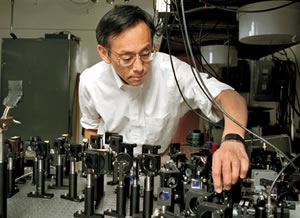 |
|
Working in a vacuum to avoid freezing the atoms into a solid state,
Chu and his team hit a beam of sodium atoms with an opposing beam
of laser light. This slowed the atoms down and allowed them to be
steered into an intersection where the six cooling laser beams met.
Atoms caught in the laser crossfire had nowhere to go without being
hit by another beam and pushed back to the center of the intersection.
A glowing cloud about the size of a pea formed, containing about a
million super-chilled sodium atoms.
“Atoms in the optical molasses take what is called a random
walk — moving around aimlessly as they’re hit from all
sides by photons,” Chu once said. “The trap is a tempting
resting place.”
Chu and his team were able to cool the atoms to 240 millionths of a degree above absolute zero. Subsequent work by American physicist William Phillips and French physicist Claude Cohen-Tannoudji, who shared the Nobel Prize with Chu, brought the temperature down to one micro-Kelvin, or one millionth of a degree above absolute zero.
Caught in optical traps at such low temperatures, atoms can be studied in great detail to help us learn more about such things as the interplay between radiation and matter. The traps can also be used to create an atom interferometer for measuring acceleration, gravity and rotations with very high accuracy. The optical molasses technique also led to the discovery of the esoteric form of matter known as a Bose-Einstein condensate.
Said Chu when he won the Nobel Prize, “It’s remarkable what simple curiosity can lead to.”
Shank Predicts Clear Sailing, Bright Horizons for Berkeley Lab’s Future
When Charles Shank sets off in his sailboat in a trans-Pacific race on Monday, he will be comforted by the fact that he left Berkeley Lab in his wake in shipshape condition.
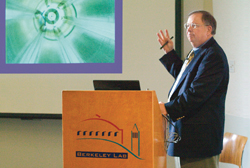 |
|
| Director Shank discusses the VENUS Ion Source during his State of the Lab talk. |
Giving his final State of the Laboratory address after 15 years at the helm of Berkeley Lab, Skipper Shank offered the following pronouncement: “The Lab has simply made an enormous impact around the world. I am extremely proud, (and) extremely optimistic about the future (of the Lab). You have an incredible opportunity to proceed on an even greater scale than before.”
And with that, his audience in the Building 50 auditorium spontaneously responded with a last, heartfelt, 30-second standing ovation.
This was a farewell talk peppered with superlatives — “extraordinary,” “amazing,” “spectacular” — as the Director inventoried achievements past and present, and promises for the future.
“It has all gone very quickly for me,” said Shank, recalling his arrival at the Lab in 1989. “We are a somewhat different lab than we were 15 years ago. We’re 65 percent larger, and poised to have an incredible future.”
“Somewhat different” is an understatement. He showed a slide which reflected steady budget increases, from just over $300 million in 1990 to a record $521 million this year. And the largest slices of the pie today — for example, in life sciences, computing, the Advan-ced Light Source, and materials sciences — were small or emerging programs when Shank moved from Bell Labs to take over Berkeley Lab.
He highlighted the types of programs that will comprise the core for the future — things like x-ray science at the ALS, nanoscience and the Molecular Foundry, systems biology and medical technology, energy efficiency, and data management through high-speed computing.
Shank reflected his hope that the future includes facility developments that will support all of those areas. Among plans on the drawing board are an “e-lab” to house and demonstrate energy-saving technologies, a building to return the supercomputing center (NERSC) to the Hill from its current downtown Oakland home, and a user support facility and dormitory for visiting researchers located near the ALS.
“We’re the only lab in the system that doesn’t have (user housing on site). We’re in the process of working with third-party financing through the University of California to support this.” He expressed hopes for a 2006 opening date.
The ALS has had “an enormous impact on science, and we have a plan to carry it into the future,” he said, praising ALS Director Daniel Chemla for its success and for being “way ahead of everyone else in creating a nanoscience effort, so that now we are on the leading edge of the field.” Among the “amazing things” being planned are infrared and short-pulse x-ray sources that would take microscopy into the next generation.
In the midst of his presentation, Shank switched to a live-camera web view of construction at the Molecular Foundry, whose “spectacular capability” will be housed in “one of the most beautiful laboratories to be built anywhere in the world.” His PowerPoint illustrations of a functioning nanomotor, nano-particles that fluoresce for labeling, and a new aberration-correcting electron microscope offered a glimpse of the promise in the Lab’s future.
Shank recounted the history of the human genome program and discussed plans for the Joint Genome Institute, with Berkeley Lab as a major partner, to focus on microbes and a new field of “ecogenomics.”
“Eddy Rubin (director of the JGI) wants to use these tools to understand the ecology of the world we live in. We only know about 10 percent of the biosphere. We need a deeper understanding of how we can influence the environment.”
In quantitative biology, the Director said, the possibilities are endless. Through coupling with the medical community, Life Sciences Division Director Joe Gray hopes to “bring the strengths of technology and medicine together.” A program called BRIDGE would feature a collaboration between the Lab, UC San Francisco, and industry that would tie the bench to the clinic in unique ways that will speed treatments to the marketplace.
 |
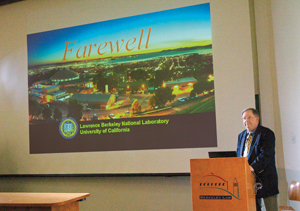 |
||
| The crowd gives Director Shank a standing ovation as he ends his final State of the Lab address. | |||
The Joint Dark Energy Mission (JDEM) proposed by NASA and the Department of Energy, in which Berkeley Lab astrophysicists are expected to play a major part, “has captured the imagination of the scientific community,” Shank said. “By the end of the decade, I look forward to that happening. I’m hoping for high water.” This was in reference to DOE Science Director Ray Orbach’s recent statement that “come hell or high water, DOE will fund JDEM.”
Shank also touched upon the work of Wim Leemans and plans for a laser accelerator driven by optical fields, nuclear science initiatives in ion source research and a positive future for the 88-inch Cyclotron, cutting-edge work in energy efficiency and renewable energy, and “Secure Earth” — a comprehensive underground research initiative that Division Director Bo Bodvarsson hopes to launch in Earth Sciences. Improvements in engineering and financial services also received his kudos.
“I’m extremely proud, and I thank all the people who worked with me,” he said, singling out “extraordinary partners” Pier Oddone and Sally Benson, his deputy directors.
When asked by former Life Sciences Division Director Mina Bissell what he would be doing in the next year, he replied, “I plan on taking a deep breath, trying to plot what I’d like to do. I’ll most likely come back to the Berkeley campus (where he has three departmental appointments). But after 15 years of the intensity of the job, one that’s all-consuming, I’ll get a chance to shake off the barnacles.”
And, asked Bodvarsson, any advice for the next director?
“Take some time to meet the incredibly talented, energetic people we have here who are leading the world in science,” Shank said. “Every day here is like being a graduate student, learning something new.”
Skipper Shank and NERSC’s Draney to Sail ‘First Light’ to Oahu
BY RACHAEL POST
What would possess Lab Director Charles Shank and NERSC’s Brent Draney to brave 2050 nautical miles of open ocean? Some call it a sailing addiction. Shank calls it “fun, adventure and the unknown.”
The two will race in the 2004 West Marine Pacific Cup from San Francisco to Oahu, departing on Monday.
“All we do for two weeks is eat, sleep and sail,” said Draney of NERSC’s Network and Security Team.
 |
|
| First Light, Director Shank’s boat, will race in the 2004 Pacific Cup |
They’ll be racing Shank’s boat, First Light, named after phenomena such as the first light from the Advanced Light Source or the first light of dawn when the sun rises over the ocean. “I wanted a name that had both scientific and sailing significance,” Shank said.
Shank, who has been sailing for 30 years, will be the skipper, and Draney, a sailor for 14 years, will be the navigator. The two of them met through mutual sailing friends and decided to combine forces and gather a crew of four. Draney’s boat barely beat Shank’s in the same race two years ago.
“Brent is a superb sailor,” Shank said. “He looks
like Spider-Man climbing up the mast.”
As the boat’s navigator, Draney has been studying wind charts
for the last few weeks to determine weather patterns.
“A navigational decision made early in the race can affect the outcome,” he said. “If you see us going to Japan, you’ll know I’ve made a mistake.”
There’s no need to fear hurricanes this time of year; the weather is usually pleasant. But getting stuck in “the eye of the non-storm” is more of a problem, Draney said. The boat must avoid the center of the high pressure system that causes no wind. No wind, no sailing.
And the boat must be in tip-top shape before heading out. “There’s no gas station you can pull up to and fix something,” Draney said. “You’re fully racing all the time.”
Two members of the crew are always on watch. That means little time to sleep. And sleep deprivation can make or break a race.
Eating well also keeps up stamina. But Shank and Draney tell the story of other sailors who chose to eat only Power Bars for the entire race two years ago. By the time they arrived in Hawaii, they were so sick they had to be hospitalized. This crew is fortunate because Shank’s boat has a freezer and refrigerator.
“We’re going to brag over the radio at evening roll call about how well we’re eating to psyche the other racers out,” Draney said.
If all goes well, Shank and Draney expect to sail from San Francisco to Kaneohe Bay, Hawaii, in about 12 days. You can follow their progress online at http://www.pacificcup.org/.
Presenters Highlight Research on Malaria Drugs, High-Speed Network Connections for the DOE
BY DAN KROTZ
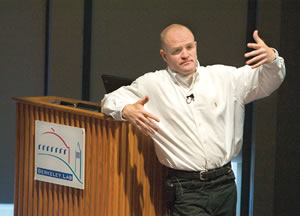 |
|
| Jay Keasling | |
What if malaria drugs became so cheap that even developing nations, some of which only spend about $4 per person per year on healthcare, could afford them? Perhaps doctors could finally eradicate a disease that still kills up to 2.7 million people each year.
Jay Keasling of the Physical Biosciences Division is working to drive down the price of malaria drugs. He recently inserted genes from yeast and the sweet wormwood tree into the bacterium Escherichia coli, and developed a chemical pathway to produce a chemical precursor to the antimalarial drug artemi-sinin. The pathway is much more efficient than current production methods.
“Our approach is to engineer E. coli so that it produces artemisinin from an inexpensive renewable source,” Keasling said Wednesday in the third installment of the Summer Lecture series.
Keasling is head of the nation’s first Synthetic Biology Department, located here at Berkeley Lab, where it can leverage the combined resources of the Advanced Light Source, the National Energy Research Scientific Computing Center (NERSC), and the under-construction Molecular Foundry. The department will help pioneer a new field aimed at finding biologically-inspired ways to develop disease-fighting therapies, convert renewable resources into energy, destroy pathogens, and clean up environmental contaminants.
Last Wednesday, Bill Johnston’s lecture outlined how the Energy Sciences Network (ESnet), a high-bandwidth network funded by DOE’s Office of Science, gives scientists fast, secure access to major DOE facilities, as well as more than 100 other networks worldwide.
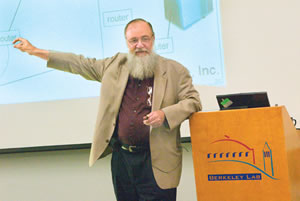 |
|
| Bill Johnston |
“The process of large-scale science is changing,” said Johnston, manager of ESNet, which is operated here at Berkeley Lab. “For example, studying cosmic microwave background — a key tool in studying the cosmology of the universe — requires combined observations from many instruments.”
Johnston outlined how ESNet is helping to facilitate this growing trend toward muli-institutional and multidisciplinary scientific endeavors. Although fewer than 15 people operate the network, it enables
scientists from across the nation to collaborate on such diverse projects as climatology research, the development of the Spallation Neutron Source, macromolecular crystallography, high-energy physics, magnetic fusion energy, chemical sciences, and bioinformatics.
Coming up
Don’t miss these upcoming Summer Lectures: On June 30, Deb Hopkins of the Engineering Division will discuss a Berkeley Lab program that is developing nondestructive evaluation techniques to test a car’s structural integrity. And on July 7, Carolyn Larabell of the Physical Biosci-ences Division will outline her work using state-of-the-art microscopy technology to understand human diseases at the molecular level.
A Revolutionary Supernova Spectrograph Sees First Light
BY PAUL PREUSS
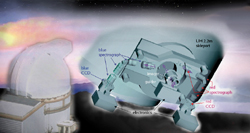 |
|
| SNIFS is mounted on the University of Hawaii's 2.2-meter telescope atop Mauna Kea on the island of Hawaii. | |
SNIFS — the moniker may be inelegant, but the concept is cutting-edge. SNIFS stands for Supernova Integral Field Spectrograph, designed to pinpoint the idiosyncrasies and determine the precise distances of Type Ia supernovae by simultaneously obtaining over 200 spectra of each target, its home galaxy, and the nearby night sky.
After two months of alignment, calibration — and bad weather — atop Mauna Kea, where SNIFS is mounted on the University of Hawaii’s 2.2-meter telescope, members of the international Nearby Supernova Factory (SNfactory) who built SNIFS were finally able to declare “first light” earlier this week.
In the early morning hours of Tuesday, June 8, SNIFS acquired its first astronomical target, a Type Ia supernova in the constellation Cygnus (the swan) designated SN 2004ca. On Sunday, June 20, an observation of SN 2004cr, a newly discovered supernova in the constellation Cepheus (the king) confirmed that SNIFS, while still in its commissioning phase, is ready for operation.
Collecting candles
The SNfactory’s goal is to find and study over 300 nearby Type Ia supernovae, the “standard candles” whose measurement revealed that the expansion of the universe is accelerating.
“Better knowledge of these extraordinarily bright and remarkably uniform objects will make them even better tools for measuring the cosmos,” says astronomer Greg Aldering of the Physics Division, who leads the SNfactory collaboration. “Type Ia supernovae are the key to understanding the mysterious dark energy that’s causing the universe to expand ever faster.”
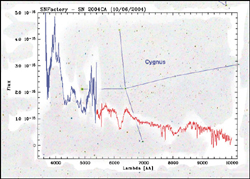 |
|
| SNIFS obtained a spectrum of SN 2004ca, in the constellation Cygnus, several days before the supernova reached its maximum brightness. |
SNIFS produces a spectrum at each position within a six-by-six-arc-second region around a target supernova, including its home galaxy and surrounding sky, using an “integral field unit” consisting of an array of individual lenslets. Light extracted from the telescope’s field of view by a small prism is directed to either blue or red-sensitive, eight-megapixel, astronomical CCD cameras, which together collect all the optical light from each supernova.
A separate photometry camera, running in parallel with the spectrograph under identical observing conditions, allows spectra to be corrected for variables such as thin cloud cover. A guide camera keeps the spectrograph precisely on target by measuring the position of a guide star within the telescope’s wider field of view once each second, adjusting aim if necessary.
SNIFS’ body was built by the SNfactory’s French collaborators; its cameras were developed at Berkeley Lab with help from Yale University; and instruments from the University of Chicago monitor performance. Flown from France to Hawaii in March, SNIFS was test-assembled at sea level, then taken apart and reassembled on top of the nearly 14,000-foot summit of Mauna Kea.
“At sea level we made sure everything was in order and also
rehearsed the assembly,” Aldering says. “When you get
to 14,000 feet, things get tricky. Everybody carries a ‘dumb
list’ so they don’t start off to do something and then
forget what it was.”
Says Aldering, “Now that SNIFS is in regular operation, our
daily lives have changed dramatically.” After years of planning
and long-distance meetings, including monthly videoconferences, “the
activity level has escalated — every day we have to react instantly
as our new supernova data come pouring in.”
A full schedule ahead
The SNfactory finds supernova through automated wide-field sky surveys. Data from the QUEST-II group at Palomar Observatory and the Near Earth Asteroid Tracking team are transmitted to the National Energy Research Scientific Computing Center (NERSC) for identification of candidates; SNIFS studies the most promising in detail.
“We’ll be getting a few candidates each night of the year,” Aldering says, “more than the entire current worldwide rate of discovery.”
Ideal are recently exploded Type Ia supernovae, near enough for accurate measurement of their spectra and light curves (rising and falling brightness) but far enough away to be “in the smooth Hubble flow” — that is, whose redshifts are due mostly to the expansion of the universe, unaffected by the motion of their home galaxies through space.
Collecting large numbers of Type Ia supernovae in the Hubble flow will help the SNfactory provide a basis for choosing among the many competing theoretical models of dark energy.
Members of the Nearby Supernova Factory team include Greg Aldering, Peter Nugent, Saul Perlmutter, Lifan Wang, Brian C. Lee, Rollin Thomas, Richard Scalzo, Michael Wood-Vasey, Stewart Loken, and James Siegrist from Berkeley Lab; Jean-Pierre Lemonnier, Arlette Pecontal, Emmanuel Pecontal, Chris-tophe Bonnaud, Lionel Capoani, Dominique Dubet, Francois Heunault, and Blandine Lantz from the Centre de Recherche Astrono-mique de Lyon (CRAL); Gerard Smadja, Emmanuel Gangler, Yannick Copin, Sebastien Bongard, and Alain Castera from the Institut de Physique Nucléaire de Lyon (INPL); Reynald Pain, Pierre Antilogus, Pierre Astier, Etienne Barrelet, Gabriele Garavini, Sebastien Gilles, Luz-Angela Guevara, Didier Imbault, Claire Juramy, and Daniel Vincent from the Laboratoire de Physique Nucléaire et de Haute Energies (LPNHE); and Rick Kessler and Ben Dilday from the University of Chicago. Recently the astrophysics group at Yale University, under the leadership of Charles Baltay, has joined the Nearby Supernova Factory.
For more about the Nearby Supernova Factory, visit http://snfactory.lbl.gov/.
EETD’s Levine Discusses State’s Energy Challenges
BY PAM PATTERSON
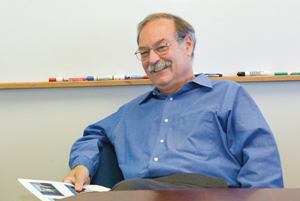 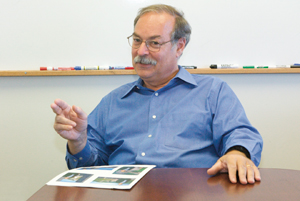 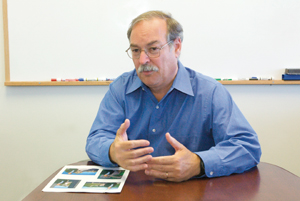 |
|
| Mark Levine | |
As director of Berkeley Lab’s Environmental Energy Technologies Division (EETD), Mark Levine oversees a diverse portfolio of energy research programs, many of them dedicated to developing new technologies to use and store energy more efficiently and with less environmental impact. EETD also conducts air quality research and has had a long-standing interest in indoor environmental quality, as well as a robust program to analyze energy efficiency policies both in the United States and internationally. In addition, the division has made significant contributions to international organizations, including the Inter-governmental Panel on Climate Change, with studies of measures to reduce greenhouse gas emissions. The View talked with Levine about some of the energy challenges ahead.
VIEW: How would you assess the energy outlook for California this summer, when demand is traditionally at its peak?
LEVINE: All of the analysis says that we are in good shape for this summer. The concern is for a few years out, where we may not have adequate supply in the case of an unseasonably hot summer, which we’ve had a fair share of in the recent past.VIEW: What programs does EETD have at present to help California address its energy challenges?
LEVINE: We do a great deal. Most important are the many research programs that we have carried out to support new technologies for using energy more efficiently in the state. We’ve completed a major research effort on energy savings and indoor air quality in California commercial buildings. We’re studying advanced lighting controls for buildings in California. We have worked on reducing leakage from ducts in both residential and commercial buildings based on our invention of a very new approach to sealing ducts. We are also working on buildings that house arrays of computers — and have large air conditioning loads — to reduce demand in these buildings. California has an especially large number of such buildings.VIEW: Are there any new programs on the horizon?
LEVINE: We’re very excited about a new venture, in which we will run a new “demand response” research center for the California Energy Commission. This relates to the tremendous benefits that could result if we could instantaneously reduce electricity demand during periods of shortages or very high electricity costs. We have just run a demonstration program that showed for the first time the capability of doing such demand reduction automatically. But there’s considerable research needed to make such systems cost effective.In addition, we are very active in research to help the state stabilize the electricity grid. We’re especially pleased with the visualization tools that help the grid operators understand a great mass of data very quickly, and thus be in a much better position to respond to crises should they occur.
In the event that we are in a shortage situation again, we have also built a tool for consumers in California. This is a website that demonstrates options for reducing energy use.
VIEW: The California Energy Commission estimates that the state’s electricity demand is growing every year by about 1,000 megawatts. How can we best address that challenge — add more power generation facilities or promote more conservation measures?
LEVINE: It’s often not an “either-or” question. We need to pursue energy efficiency very actively, and there are needs for utility and government programs because consumers need help in figuring out what are the best steps to take. But we also need new power as the state grows. It’s too often that the two needs are seen in opposition to each other, when both supply increases and efficiency gains are needed to ensure a sound energy system. Of course, EETD’s major work is on energy efficiency, so that’s the area that we tend to emphasize.VIEW: Tell us about the Consortium for Electric Reliability Technology Solutions (CERTS).
LEVINE: Believe it or not, the nation had no electricity reliability research program in the late 1990s. Charles Curtis, former deputy secretary of energy, was especially concerned about the issue for the well-being of the nation. He worked with us and an executive of Southern California Edison to help create a new national program on electricity reliability research, which started in 1999. Berkeley Lab manages the overall effort, but the research is carried out by three other national labs as well (Pacific Northwest, Oak Ridge, and Sandia), along with a consortium of leading universities under the overall management of Cornell. We’ve created research in real time grid management tools, markets and reliability, the integration of distributed energy systems into the grid, and other areas.We have also been very involved in the major policy studies that have been carried out at the national level. Joe Eto from Berkeley Lab has been the overall manager of CERTS and has been very active and busy in that role.
VIEW: What role does EETD play in setting energy policy for California and the U.S.?
LEVINE: We do not play any direct role in the setting of energy policy, but we are often asked to do analysis of various issues that relate to policy. One area where we have been extremely active is in the technical and economic analysis of appliance energy efficiency standards. But even with a staff of more than 25 researchers, our role is to provide the Department of Energy with information, which they use in various ways to make decisions on the desirable level of standards.VIEW: What work is EETD doing on alternative energy futures?
LEVINE: We have co-led the most comprehensive analysis of energy futures for the United States, the “Clean Energy Futures Study,” completed several years ago. We have worked with China to develop tools that they have, in turn, used to assess energy futures for that country. We were very excited to learn that the tools that we created with our Chinese colleagues have been officially adopted as the energy planning tools for the Chinese government. This work is ongoing, as China is struggling to understand how it can reduce recent unexpectedly high energy growth after having controlled energy growth rather well for the past twenty-plus years.We are just now beginning a project that will attempt to understand at the global level, for the very first time, scenarios of energy demand at the level of technology for major end uses. In short, we have been very involved in the complex process of integrating our knowledge about energy use into consistent and often very detailed scenario analysis. In time, the global analysis may be important in improving our assessment of the role that energy efficiency — and other factors affecting end use energy — can play in reducing the growth of greenhouse gas emissions, a topic of vital importance to us all.
Berkeley Lab View
Published every two weeks by the Communications Department for the employees and retirees of Berkeley Lab.
Reid Edwards, Public Affairs Department head
Ron Kolb, Communications Department head
EDITOR
Monica Friedlander, 495-2248,
msfriedlander@lbl.gov
Associate EDITOR
Lyn Hunter, 486-4698 lhunter@lbl.gov
STAFF WRITERS
Dan Krotz, 486-4019
Paul Preuss, 486-6249
Lynn Yarris, 486-5375
CONTRIBUTING WRITERS
Jon Bashor, 486-5849
Allan Chen, 486-4210 David Gilbert, 925-296-5643
FLEA MARKET
486-5771, fleamarket@lbl.gov
Design & Illustration
Caitlin Youngquist, 486-4020
TEID Creative Services
Communications Department
MS 65, One Cyclotron Road, Berkeley CA 94720
(510) 486-5771
Fax: (510) 486-6641
Berkeley Lab is managed by the University of California for the U.S. Department of Energy.
Online Version
The full text and photographs of each edition of The View, as well as the Currents archive going back to 1994, are published online on the Berkeley Lab website under “Publications” in the A-Z Index. The site allows users to do searches of past articles.
Flea Market
- AUTOS & SUPPLIES
‘90 BMW 735i, 112K mi, silver, auto, leather, sunrf, ac, pwr win & seat, exc cond $5,900 Eran, (925) 957-1998
HOUSING
ALBANY, 2/2 condo, fully furn, spacious 1,234 sq ft, sunny, quiet & eleg, sleeps 4, laundry rm, views, pool, exercise rm, recreation rm, 2-car garage, nr restaurants/El Cerrito Plaza/BART/pub trans, 848-1830, gfchew@mindspring.com
BERKELEY, north side furn apt, 1 bl to campus, DSL & other util incl, Paul X7363, Jin, 845-5959, jin.young@juno.com
BERKELEY, 4 bdrm/2 bth, immaculate house & garden, $3,000/mo, Paul, X7363, Jin 845-5959, jin.young@juno.com.
BERKELEY, Carleton/Grant, nr BART/ shops/Lab shuttle, close to LBNL, newly renov 2 bdrm apt, grnd flr of 2-story Victorian house, sunny southern exposure, front garden, w&d, custom tile flrs, no smok/pets, $1,400/mo, incl part utils, avail immed, Richard or Hope, 845-1723
BERKELEY, residential community of UC scientists, Lab personnel and grad students, Hearst Commons, 1146-1160 Hearst nr University & San Pablo, nr pub trans/BART/bike path, reserved parking, indoor/outdoor liv in studio townhouses w/ decks, furn can be provided, hardwd flrs, skylights, dw, disposals, ac, intercom, sec, wired for cable or satellite TV, Ian, 220-2051, $850, hearst.commons@jps.net, pictures at www.live-work.us
CENTRAL BERKELEY, furn rms, $300/wk or $800/mo, walk to Lab shuttle & shops, kitchen, laundry, DSL incl, Paul, X7363 or Jin, 845-5959, jin.young@juno.com
KENSINGTON, rm avail for visiting scholar during 7/01-8/01/04, garden setting, kitchen access, Ruth, 526-6730
NORTH BERKELEY, by week/mo, fully furn 1/1 flat, quiet, spacious & comfortable, dish TV, laundry rm, priv garden, gated carport, walk to Lab shuttle/UCB/ pub trans, BART, downtown Berkeley, 848-1830, gfchew@mindspring.com
NORTH BERKELEY HILLS, 1 bdrm/1 bth, full kitchen & liv rm, 1 person flower-garden apt w/ fp, off Grizzly Peak Blvd, 1 blk to bus #65, nr Lab/UCB/Tilden Park, avail now, $900/mo incl util & laundry, no smok/pets, 1st+last+sec, $250, Barbara or Bill, 524-5780, 8 am – 9 pm
NORTH BERKELEY HILLS, studio, sunny, quiet, priv, in garden setting, lovely neighborhood, hardwd flrs, kitchen w/ gas stove, bthrm w/ bthtub, dressing rm, $900/mo, last mo+cleaning dep, mo-to-mo, 1 person only, no pets/smok, Mrs. Wurth, 527-5505, after 1:30 pm, nonet@xoma.com
OAKLAND HILLS, quiet but sunny 2 bdrm house, safe & long established neighborhood, recently remodeled w/ new carpet, paint, heater, small wooden deck, skylights, energy efficient windows, & jacuzzi tub, lge kitchen, indoor w/d, closet, sep double car garage, nr Lab, $1,400/mo, 1st + last mo + sec dep, Kasia, (925) 639-5299 or (925) 673-5029
POINT RICHMOND, nr shops/rest/cafes/ theater, nice inner courtyrd w/ lush garden, spacious, priv balcony, storage closets, newly updated kitchen, carpet & paint, gated off street, reserved parking, no pets/smok, 2 bdrm/1 bth, $1,100/mo,
1 bdrm/1 bth, $900, Evan, X6784, 525-7655
RICHMOND MARINA, share 2 bdrm/
2 bth w/ male professional, quiet, clean, spacious & comfortable, w&d, kitchen w/ d/w, onsite gym, pool & jacuzzi, walk to bay trail & Marina, $650/mo + util, flexible lease, avail 6/29, Calvin, 364-9945, calvinf2004@yahoo.com
ROCKRIDGE, lge bdrm in nicely furn, quiet & spacious 2/1 flat, share w/ owner in duplex, priv deck, cable TV/VCR, laundry, garden & patio behind house, 1.5 blocks to pub trans/Lab shuttle at Rockridge BART, Barbara, 652-7044, Barbird@aol.com.
MISC ITEMS FOR SALE
TICKETS (4), 7/28, Sunday, 1:05 p.m., lower section, row 30 at back of infield at 3rd base, b/o, Mark, X6581
VCR, JVC, 2 years old, good cond, $50/bo, Deborah, X 4465
WANTED
RN OR LVN for part-time, in-home respite for Alameda family, looking for professional to provide care for disabled 14-yr-old daughter, anticipate 4-hour shifts 3 to 4 times/wk, late June through early Sept, scale level wages, Chuck, 486-4461, 521-6368-
VACATION
Lake Tahoe, house, 3 bdrm/2.5 bth, fenced yrd, quiet, sunny, great views of water & mountains $195/night, 2 night min, Bob, (925) 376-2211
NORTH LAKE TAHOE, house at Kings Beach, 3 bdrm/2 bth, sleeps 6, full kitchen, liv rm & din area w/ fp, quiet cul-de-sac, great neighborhood, 1 mi from public beach, no smok/pets, $150/night, 2 nights min + $75 cleaning fee or $725/week, Vlad or Linda, 849-1579
PARIS, FRANCE, nr Eiffel Tower, furn, eleg & sunny 2 bdrm/1 bth apt, avail yr-round by week/mo, close to food stores, restaurants, pub trans/shops, 848-1830
SO LAKE TAHOE, spacious chalet in Tyrol area, close to Heavenly, fully furn, sleeps 8, sunny deck, pool & spa in club house, close to casinos & other attractions, $150/day + $75 one-time clean fee, Angela, X7712, Pat or Maria, 724-9450
Flea Market Policy
Ads are accepted only from Berkeley Lab employees, retirees, and onsite DOE personnel. Only items of your own personal property may be offered for sale.
Submissions must include name, affiliation, extension, and home phone. Ads must be submitted in writing
(e-mail: fleamarket@lbl.gov, fax: X6641), or mailed/delivered to Bldg. 65.
Ads run one issue only unless resubmitted, and are repeated only as space permits. Ads must be submitted in writing and be no more than 50 words in length. The submission deadline for the April 30 issue is Friday, April 23.
People, AWARDS & HONORS
Outstanding Performance Awards Honor Excellence
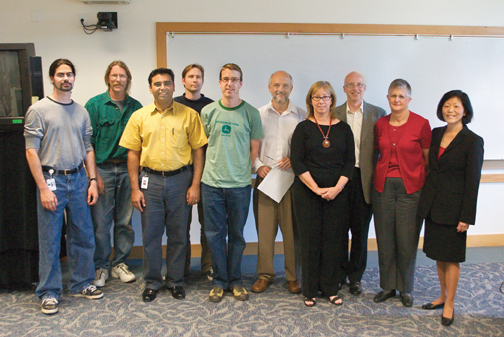 |
|
| On June 15, Deputy Director for Operations Sally Benson hosted a reception for winners of Outstanding Performance Awards for the month of April 2004. Dozens of employees attended the event, which was held in the cafeteria dining area. Pictured here, left to right, are: Dan Klinedinst, Robert Macfarlane, Vik Bhatia, Anthony Lincoln, Dale Federighi, Deputy Director Pier Oddone, Sally Benson, Chuck Axthelm, Mary Clary, and Diana Brown.OPA recipients not pictured are Vickie Ng, Chun Sheng Li, and Thanasis Bothos. |
Honoring the ASD Staff
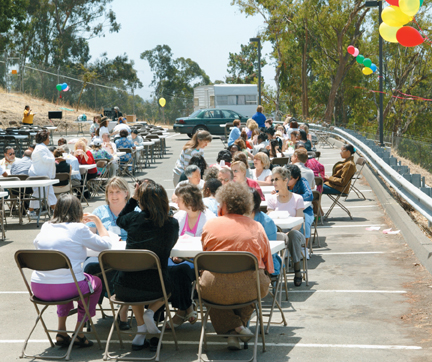 |
|
| On
Wednesday, June 16, the “Z” parking lot above the
cafeteria was turned into festive grounds to honor the Lab’s
administrative staff with a fun-filled barbecue lunch, complete
with DJ, a raffle (thanks to employee-donated prizes) and balloons
galore. The event was part of the Lab’s first ASD Staff
Appreciation Day, which is separate from the annual ASD picnic.
The lunch was not a stand-alone celebration, but part of a series
of activities to honor the 300 ASD staff members at the Lab. “It was a big day-long celebration,” said Shannon Buckley, chair of the Staff Appreciation Day team and administrative supervisor for AFRD. “We delivered flowers to ASD staff, ran short films, served popcorn, held a raffle … I hope this becomes contagious and other Lab groups will do more fun activities.” |